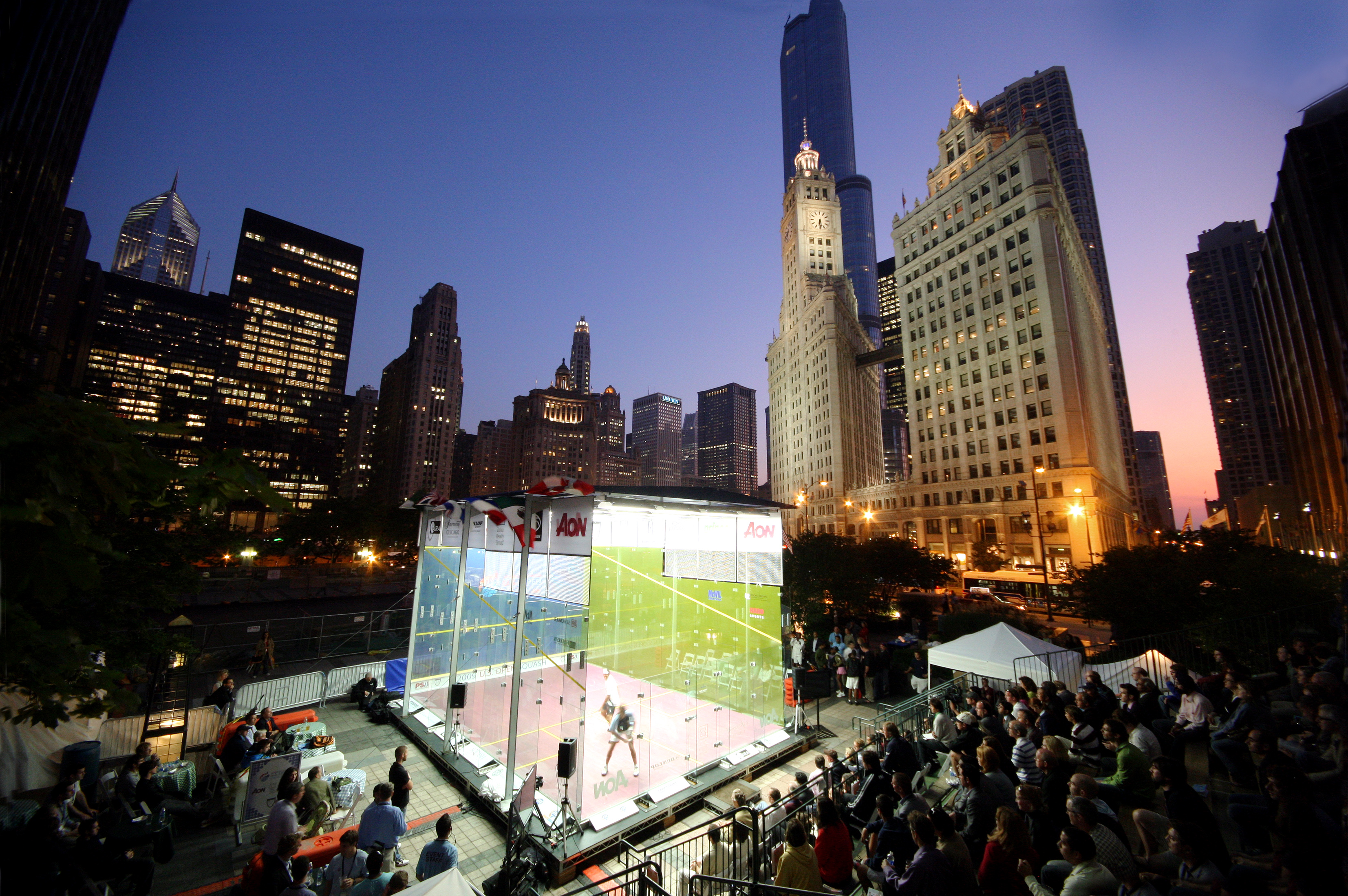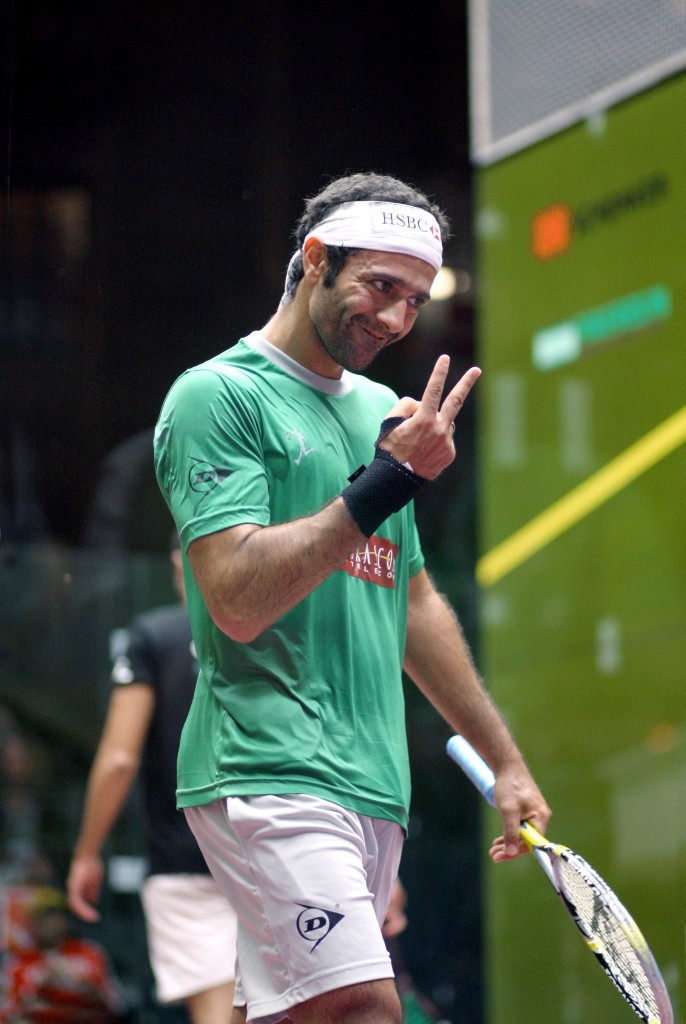
By Jay D. Prince
Photos by Steve Line/SquashPics.com
Two years after it was last staged, in New York City, the U.S. Open made a triumphant return to the squash landscape in the United States. And while the one-year experiment in Gotham City, on the heels of nine years in Boston, struggled to gain traction, it looks as though the marquee event of U.S. SQUASH may have found itself the perfect home in Chicago.
Twelve months ago, just before the top PSA players in the world were to travel to New York for the Open, the event was abruptly cancelled due to insufficient sponsorship as our economy began to sour. At the time, U.S. Squash CEO Kevin Klipstein was quoted as saying, “We are clearly disappointed by these developments—this is a setback. We will start planning immediately for 2009 to ensure the U.S. Open re–takes its place among the most prestigious squash tournaments in the world.”
Message sent, and mission accomplished. Once headed to Chicago, the event flourished. For the second time ever in the US, a major PSA event would be staged outdoors, in the McWil Courtwall glass court. The last time? September 2008, in Pioneer Court, in Chicago. Rain was the nemesis then.
Not this year. After erecting the court in the same place on Michigan Avenue, a cover was put over the court for protection from the elements. Guy-wires secured the court from potential winds, banners with sponsor logos put in place (most prominently, AON, the title sponsor), bleachers, bar and a barbecue stand were the finishing touches.
But what makes an event like the U.S. Open unique is players. Though World No. 1 Karim Darwish was a no-show, as was World No. 2 Gregory Gaultier, the draw was littered with world champions. Egyptians Ramy Ashour and Amr Shabana, seeded No. 1 and 2 respectively, and Boston-based Australian David Palmer, have won six of the last seven World Open titles.
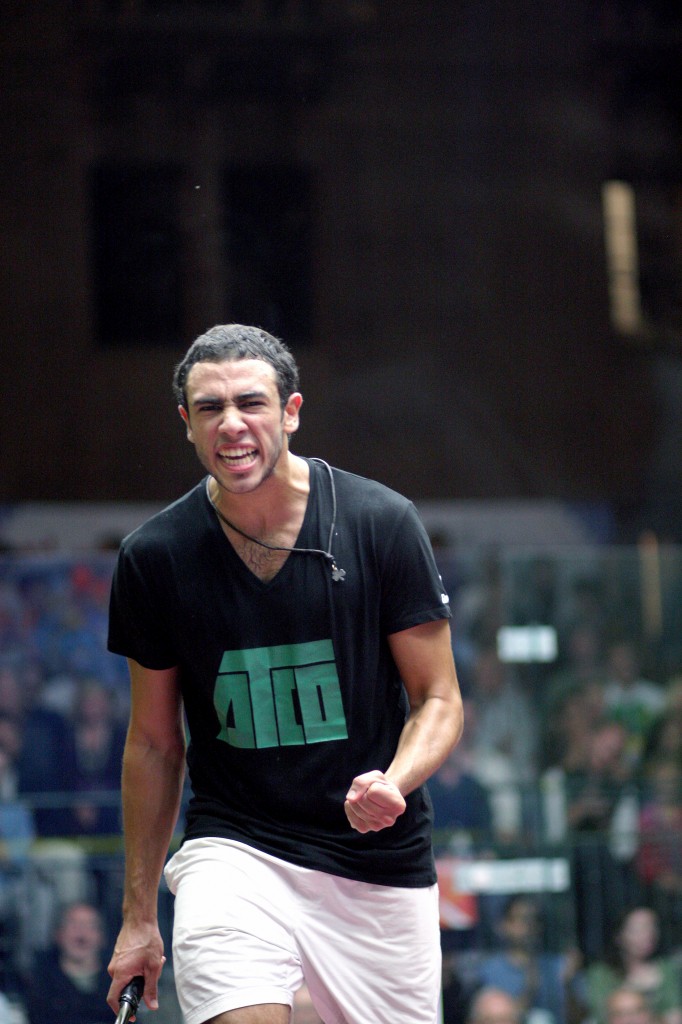 This year’s U.S. Open was a tale of two tournaments. There were the Egyptians, and everyone else. And there was the court by day and the court by night. Early evening matches presented unusual challenges, particularly when the sun popped in and out between skyscrapers. A curtain of sorts was hoisted as needed along one side wall, using a mechanical lift. It was humorous at times to see players acting like grounds crew directing the curtain man. But once dusk settled in, the court glistened in front of the Tribune Tower with several hundred spectators gawking at the abilities of the players on court each night.
This year’s U.S. Open was a tale of two tournaments. There were the Egyptians, and everyone else. And there was the court by day and the court by night. Early evening matches presented unusual challenges, particularly when the sun popped in and out between skyscrapers. A curtain of sorts was hoisted as needed along one side wall, using a mechanical lift. It was humorous at times to see players acting like grounds crew directing the curtain man. But once dusk settled in, the court glistened in front of the Tribune Tower with several hundred spectators gawking at the abilities of the players on court each night.
Joining the dominant Egyptians, three of whom reached the quarterfinals, were two American players—a first in the U.S. Open since becoming a softball event in 1985. Julian Illingworth, who just missed qualifying in 2007, successfully negotiated his way into this year’s draw with wins over Lefika Ragontse and Liam Kenny in the qualies. Gilly Lane, granted a wild card, as he was in 2007, pushed England’s Peter Barker in three solid games before falling. Meanwhile, Illingworth took on Barker’s teammate, James Willstrop, in the first round. Willstrop, just returning from ankle surgery, was heavily taped but survived the efforts of Illingworth who managed to win the third game before succumbing in four.
But Ashour and Shabana dominated the event from the start. In less than two hours of match time each, both players reached the finals. Ashour, with his frantic flash-and-dash style brushed aside Palmer in the semis, barely breaking a sweat in just over 30 minutes. Shabana needed eight more minutes to do the same to Willstrop who was still feeling the effects of a five-setter against Barker in his quarterfinal.
In the early stages of his two-and– a-half-year run as World No. 1, Shabana secured his first opportunity to become the first Egyptian to win a U.S. Open title. Unfortunately for him, Gregory Gaultier got in the way in the finals in 2006, marking Gaultier’s first Super Series tournament win. Injury stopped Shabana in 2007 when he was seeded to win the title. Instead, England’s Nick Matthew stole the show when he beat James Willstrop in that final—Willstrop had solved the Ashour–puzzle in the semis.
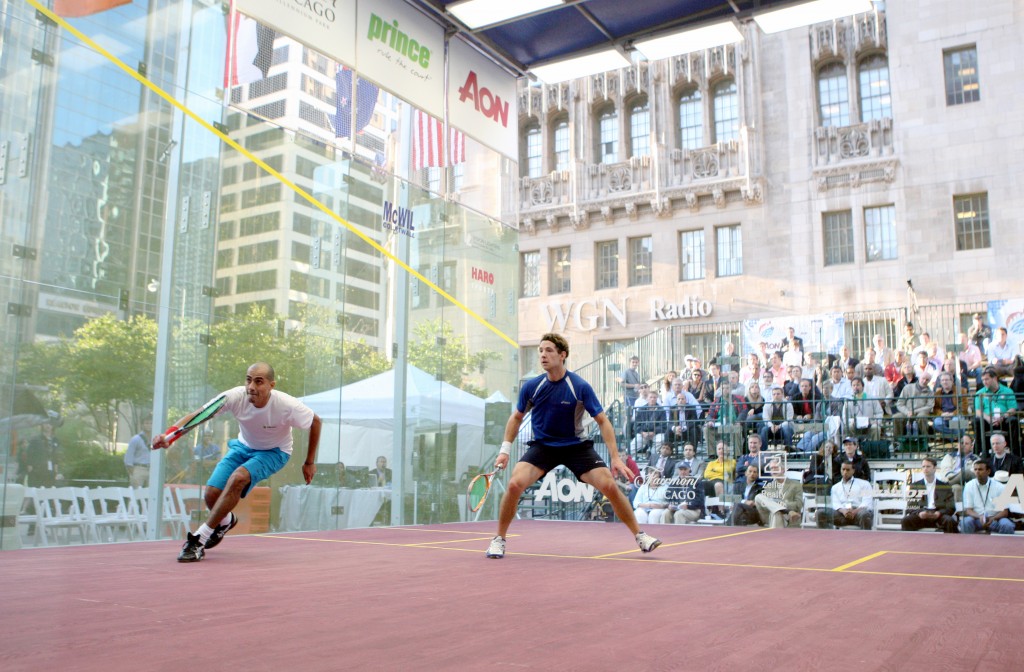
Ashour burst onto the scene three years ago after winning his second consecutive World Junior Championship. Less than a year after committing to the PSA tour full time, the phenom had vaulted to World No. 2, just behind Shabana. A rash of niggling injuries have hampered his meteoric rise, but Ashour has not slipped below World No. 4.
The final in Chicago marked just the second time since Shabana had lost his stranglehold on World No. 1 that he faced Ashour in a tournament.The outcome then, last April in the Hurghada International, was a schooling by the pupil on the master in the semifinals. Prior to that, Ashour conquered Shabana in the 2008 World Open.
When the first ball was served in the shadow of Trump Tower just off the canal leading to Lake Michigan, Ashour and Shabana stood deadlocked head-to–head at five wins each. From the start, it looked as though Shabana would crush his younger compatriot. Not so fast.
Shabana scorched Ashour to the tune of nine points in the first two games, 11-7 and 11-2. Ashour thrives on dictating the pace of play by capitalizing on any loose angles his opponents provide. Crosscourts are gobbled up with wicked volley nicks. But Shabana gives Ashour fits with his ability to straighten the ball down the wall. Ashour goes for the drop nick, and Shabana pounces, pushing the ball tight down the wall. Ashour plays a ball straight, and Shabana hits it straighter—and tighter. Which is when Ashour’s youth starts to show. At times impatient, perhaps bored, Ashour tends to force the issue and go for his shots even when they aren’t there to be had. The result can be exactly what he got in those opening two games. A constant slap in the face that leaves him hurling Egyptian diatribes into the tips of his fingers.
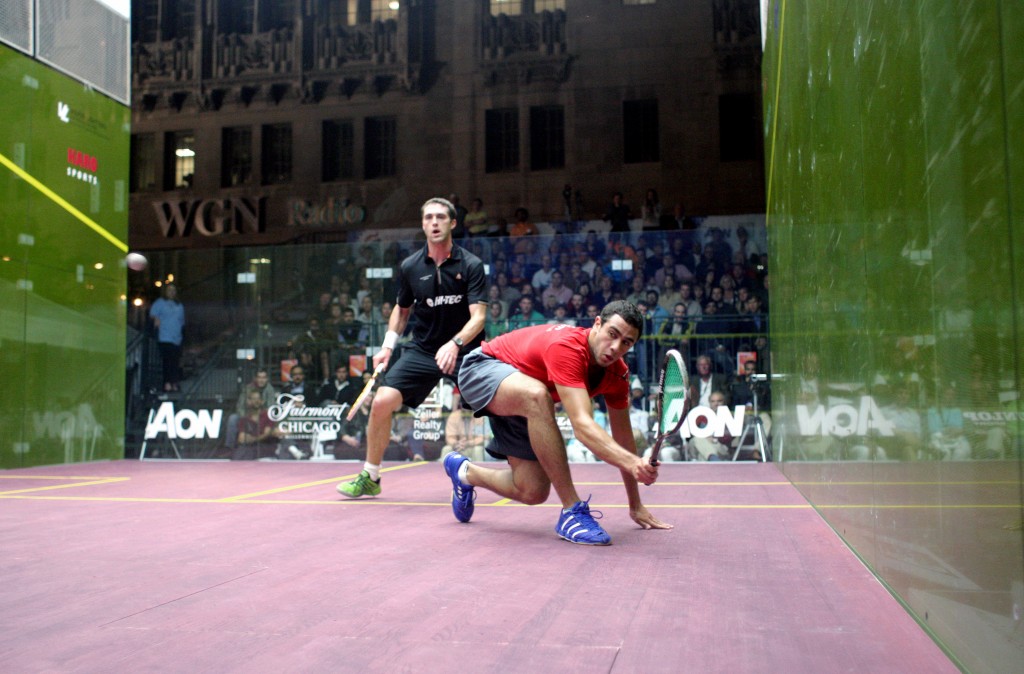
But like his blinding speed, Ashour has a knack for finding his way back into the driver’s seat. And he did it again in game three. Despite falling behind 4-0 to open the third, Ashour clawed his way back to 4-6 before finishing off the game, 11-7. A lesser player might have wilted, but Shabana was still in control.
With a quick 5-0 lead in the fourth, and just as quickly extending that to 8-3, Shabana looked poised to capture his first Open title. Just one more point and the bitter taste of losing in the final in 2006 would be gone. But like so many times before, Ashour’s arsenal of winners started flying. With blinding quickness, that three point lead was gone. Poof.
Ashour forced the game to a tiebreaker and came away from that fourth game with a 14-12 win. Somehow, the hundreds of fans in the bleachers and lining up outside the front wall were to be treated to a fifth and deciding game.
If squash were cards, the Egyptian contingent would be the trump suit. While only representing a quarter of the players in the 16-player draw, the four Egyptians all reached the quarterfinals and, were if not for the fact that Ashour had to face Wael El Hindi in his quarter, they may have taken up three of the four spots in the semis. It was fitting, then, that the final would come down to one game between two of the world’s best players.
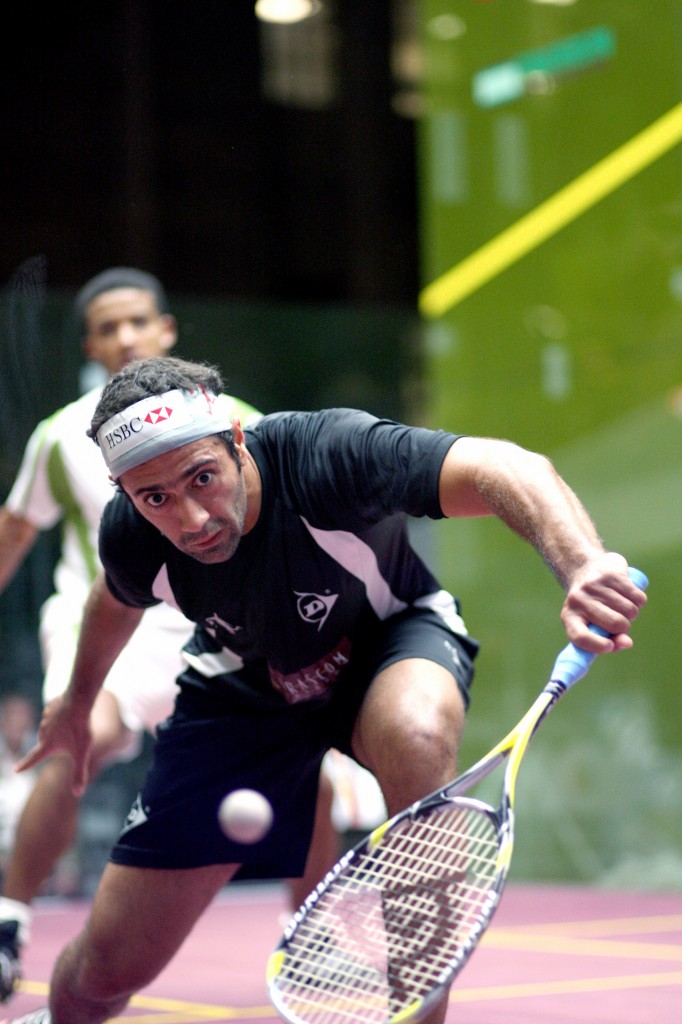
Bolstered by his blistering come back in the fourth, Ashour’s momentum continued as he jumped to a 3-1 lead in the fifth. But rather than crumbling, Shabana played with the poise of the player who held the No. 1 spot for nearly three years. A string of winners later, Shabana was back in control at 9-7.
One of the unique aspects of squash is the sportsmanship demanded by the players who occupy the same floor space. Not only are they required to make room for each other, but sometimes it’s hard for referees to make correct calls when bodies are blocking their view. At 9-7, Ashour went for a dropshot at the front left that left Shabana screaming at the referees for not calling the ball down. While as competitive as anyone, he rarely loses his head. But Ashour put an end to the fireworks when he conceded the point, putting him up against the wall with another match ball staring him in the face.
Two points later, the trump card in the suit was played and Shabana had his first U.S. Open title, 11-8 in the fifth. Afterwards, Shabana said simply, “Ramy is such a great player, and as a world champion at 21 years old he seems to have been around for years. I am pleased to win the fifth game.”
Planning is already underway for the 2010 U.S. Open. With a move expected to the spectacular Pritzker Pavillion stage at Millennium Park, the Open is anticipating a combined event featuring both the men’s and women’s professional tours. Combining efforts with METROsquash, the Chicago-based Urban Program, the hope is to expose over 2,000 youth to the sport in the built-in seating. After a year of unrest, it seems the U.S. Open has found a home. It remains to be seen if anyone can step up to overcome the hand being played by the Egyptians. But for this year, Amr Shabana held the royal straight flush.


